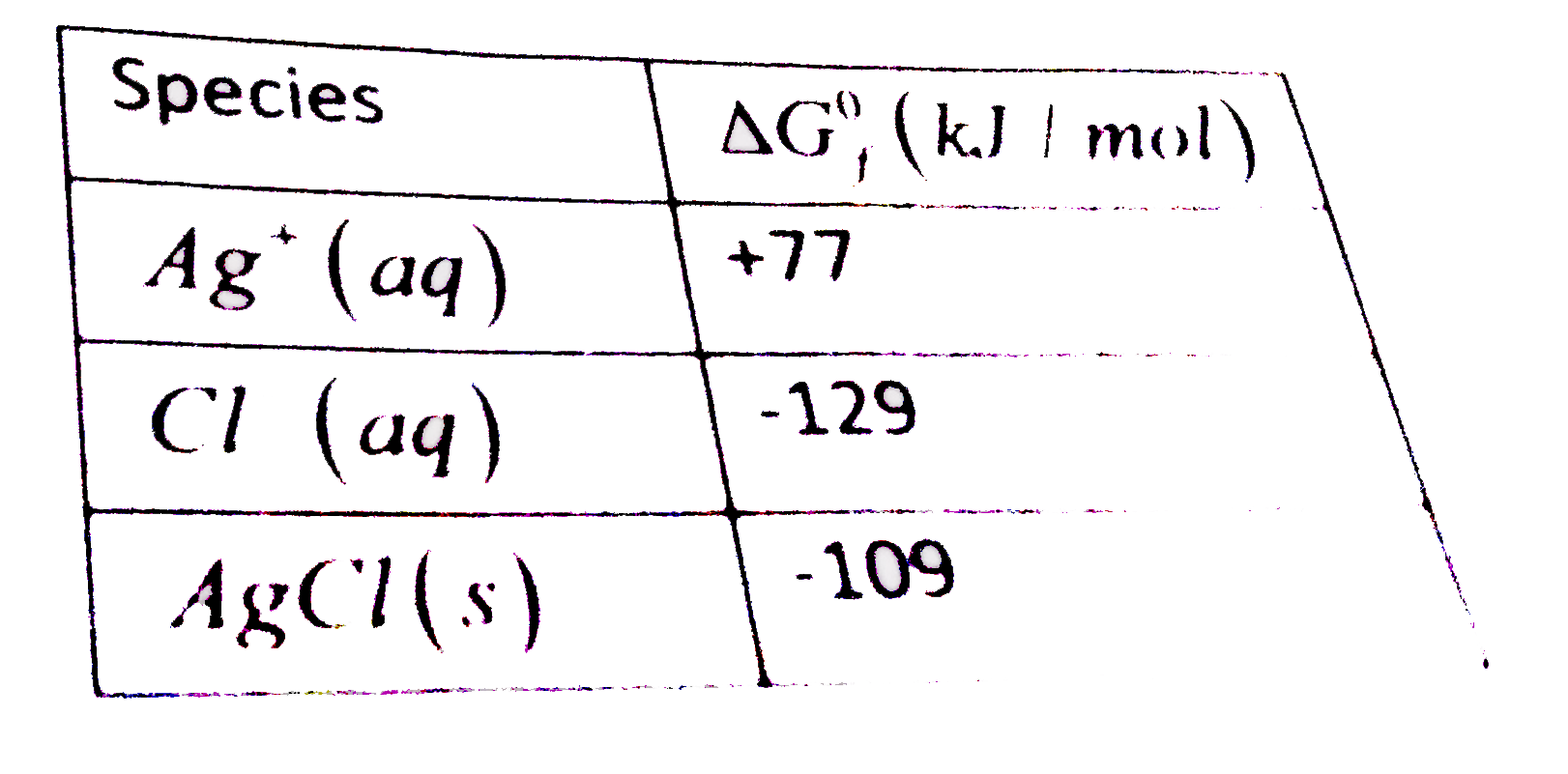The standard reduction potentials for two reactions are given below:
AgCl(s)+e−→Ag(s)+Cl−,E∘=0.22V
Ag+(aq)e−+e−→Ag(s),E∘=0.80V
The solubility product of AgCl under standard conditions of temperature (298 K) is given bySolution in Telugu
1.5×10−10
1.5×10−8
3.2×10−10
3.2×10−8
The correct Answer is:A
Step by step video, text & image solution for The standard reduction potentials for two reactions are given below: AgCl(s) + e^(-) to Ag(s) + Cl^(-) , E^@ = 0.22 V Ag^(+)(aq) e^(-) +e^(-) to Ag(s) , E^@ = 0.80V The solubility product of AgCl under standard conditions of temperature (298 K) is given by by Chemistry experts to help you in doubts & scoring excellent marks in Class 12 exams.
Topper's Solved these Questions
- BOOK - AAKASH SERIESCHAPTER - REVISION EXERCISE EXERCISE - SURFACE CHEMISTRY45videos
REVISION EXERCISE
- BOOK - AAKASH SERIESCHAPTER - REVISION EXERCISE EXERCISE - VA GROUP ELEMENTS26videos
REVISION EXERCISE
- BOOK - AAKASH SERIESCHAPTER - REVISION EXERCISE EXERCISE - CHEMICAL KINETICS39videos
REVISION EXERCISE
- BOOK - AAKASH SERIESCHAPTER - REDOX REACTONSEXERCISE - Questions For Descriptive Answers27videos
REDOX REACTONS
- BOOK - AAKASH SERIESCHAPTER - SOLID STATEEXERCISE - PRACTICE SHEET - 530videos
SOLID STATE
Similar Questions
In an adsorption experiment a graph between log x/m vs. log p is found to be linear with a slope of 45∘ . The intercept on the log x/m axis was found to be 0.3010. What is x/m if pressure is 0.6 bar
03:31View SolutionMole fraction of nitrogen in air is
02:54View SolutionN2+3H2→2NH3. The rate of disappearance of nitrogen is 0.02molL−1s−1. What is the rate of apperance of ammonia ?
02:04View SolutionHow are no electron transfer reactions different from redox reactions ?
01:53View SolutionThe closest-packing sequence ABAB....... represents
08:41View SolutionFrom the following information, calculate the solubility product of silver bromide ?
AgBr(s)+e−⇔Ag(s)+Br−(aq.)E∘=0.07Ag+(aq.)+e−⇔Ag(s)E∘=0.80V03:35View SolutionAg^(+)(aq) + e^(-) rightarrow Ag(s) E^(@) = 0.80V Co^(2+)(aq) + 2e(-) rightarrow Co(s) E^(@) = -0.28V Use the standard reduction potentials to determine the standard potential for the reaction: Co(s) + 2Ag^(+)(aq_) rightarrow Co^(2+)(aq) + 2Ag(s)
07:32View SolutionGiven these standards reduction potentials, what is the free energy change (in kJ. Mol^(-) for the reaction: Pb(s) + 2Ag^(+)(aq) rightarrow Pb^(2+)(aq) + 2Ag(s) Ag^(+)(aq) + e^(-) rightarrow Ag(s) E^(@) = 0.80V Pb^(2+)(aq) + 2e^(-) rightarrow Pb(s) E^(@) = -0.13V
03:39View SolutionUse the standard reduction potentials:
Sn2+(aq)+2e−→Sn(s) E∘=−0.141V
Ag+(aq)+e−→Ag(s) E∘=0.800V
To calcultate E∘ for the reaction:
Sn(s)+2Ag+(aq)→Sn2+(aq)+2Ag(s)03:41View Solutiona. For the reaction
Given : Ag⊕(aq)+Cl⊕(aq)→AgCl(s)

Write the cell representation of above reaction and calculat E∘cell at 298K.
Also find the solubility product of AgCl.
b. If 6.539×10−2g of metallic zinc is added to 100ml saturated solution of AgCl. Find the value of
log10.[Zn2+][Ag+]2
How many moles of Ag will be preciptated in the above reaction. Given that
Ag++e−→Ag,E∘=0.80V
Zn2++2e−→Zn,E∘=−0.76V07:32View SolutionThe equilibrium constant (K) for the reaction
Fe2++(aq)Ag+(aq)→Fe3+(aq)+Ag(s) will be
Given E∘(Fe3+/Fe2+)=0.77V,
E∘(Ag+/Ag)=0.80V03:41View SolutionThe standard reduction potential for two reactions are given below
AgCl(s)+e−→Ag(s)+Cl−(aq),E∘=0.22V
Ag+(aq)+e−→Ag(s),E∘=0.80V
The solubility product of AgCl under standard conditions of temperature is given by06:39View SolutionThe standard rectuion potentials for two half-cell reactions are given below Cd^(2+)(aq)+2e^(-)rarrCd(s),E^(@)=-0.40V Ag^(+)(aq)+e^(-)rarrAg(s),E^(@)=0.80V The standard free energy change for the reaction 2Ag^(+)(aq)+Cd(s)rarr2Ag(s)+Cd^(2+)(aq) is given by
04:22View SolutionCalculate the reduction potential for the following half cell reaction at 298 K. Ag^(+)(aq)+e^(-)toAg(s) "Given that" [Ag^(+)]=0.1 M and E^(@)=+0.80 V
03:50View SolutionThe standard reduction potential for two reactions are given below
AgCl(s)+e−→Ag(s)+Cl−(aq),E∘=0.22V
Ag+(aq)+e−→Ag(s),E∘=0.80V
The solubility product of AgCl under standard conditions of temperature is given by03:06View Solution

